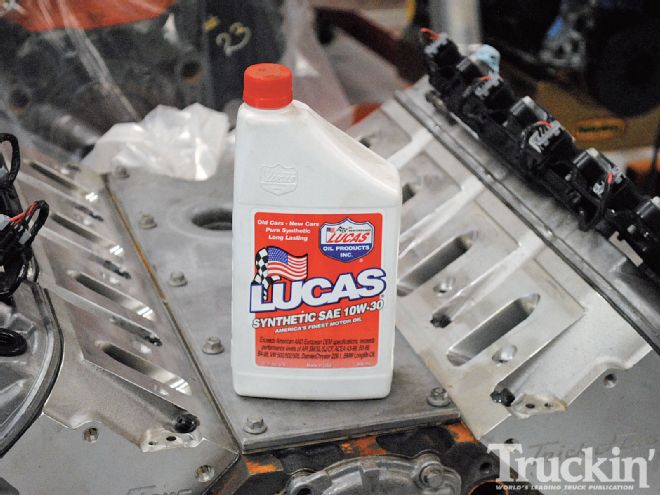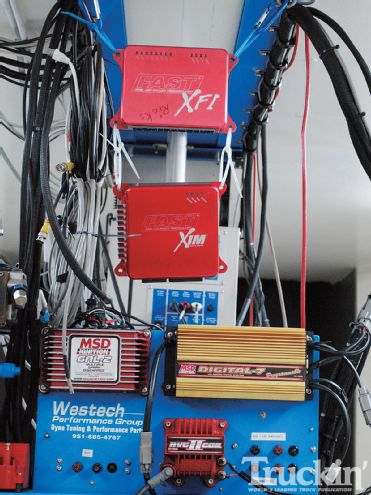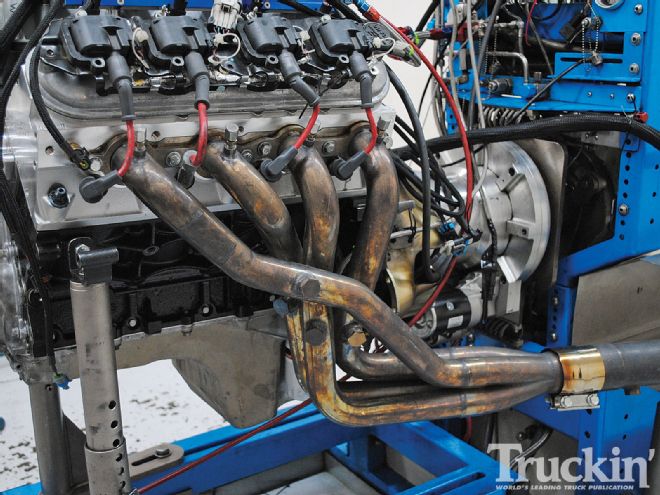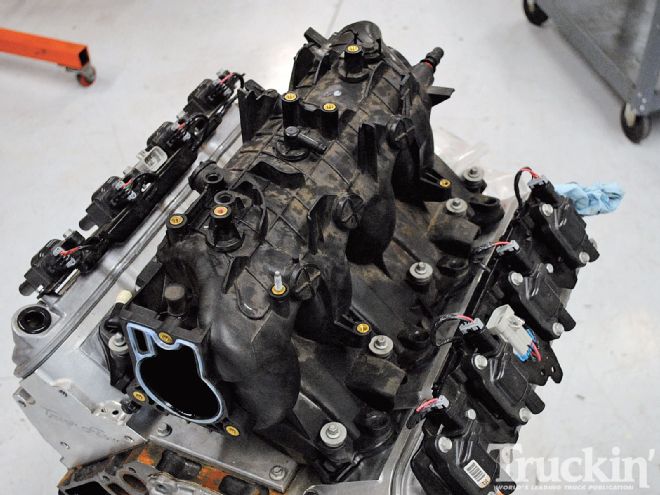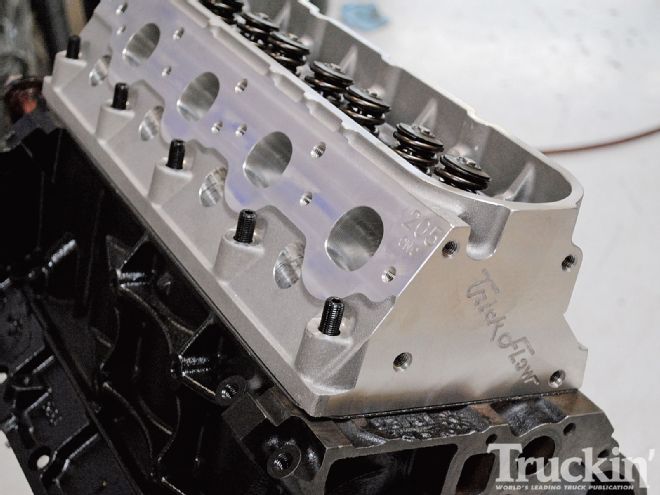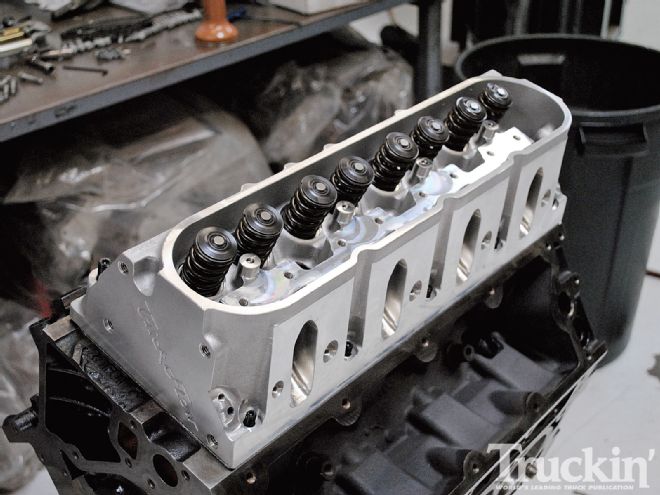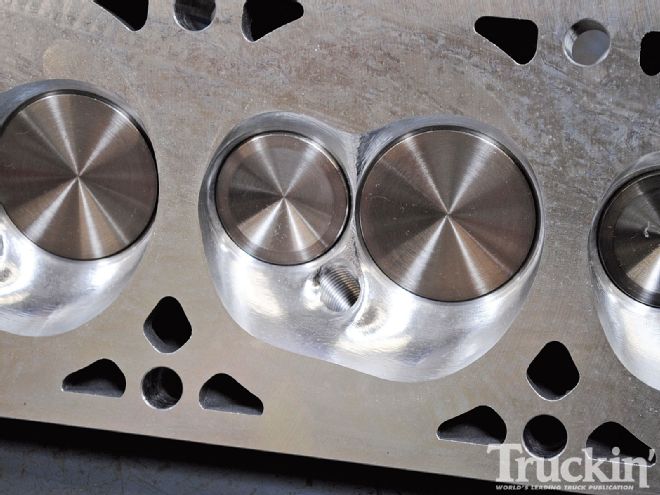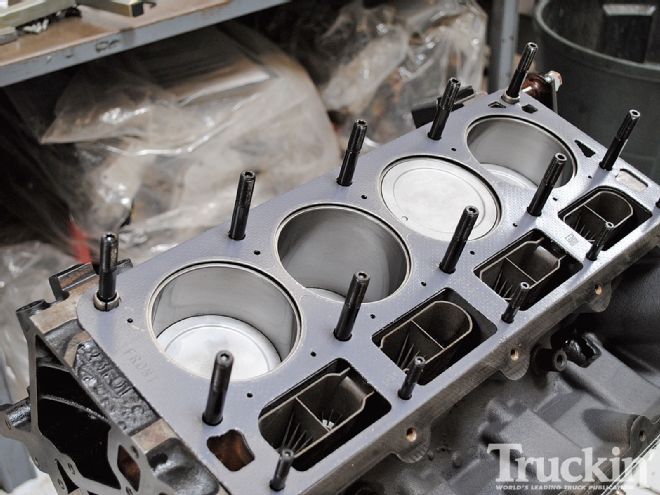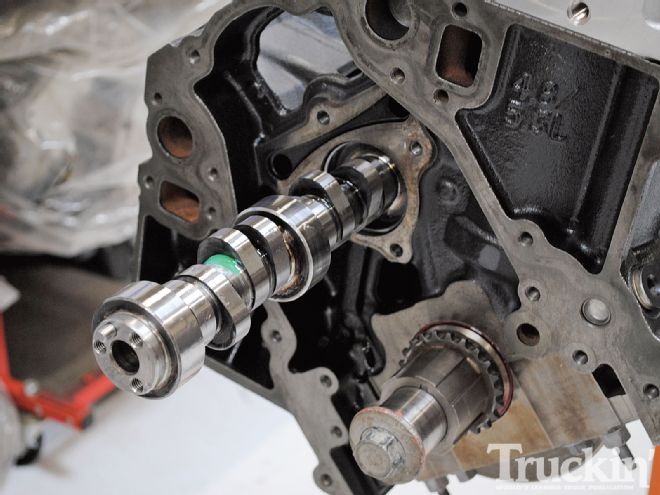The current LS-series small-block certainly had big shoes to fill, after all, the small-block Chevy had been around for some time and garnered more than its fair share of awards and racing success. Compared to the General's original small-block, the modern LS engine offers the veritable trifecta of performance. The LS motors are simultaneously lighter, more powerful, and more fuel efficient than their predecessors (all very important for truck owners). Offered in a variety of different displacement and power outputs, ranging from as low as 270 hp for the 4.8L up to 638 hp for the supercharged LS9 ZRI motor, performance enthusiasts have plenty to choose from. Like the previous generation of small-blocks, the LS family has its bread-and-butter motor in the form of the 5.3L (LM7). Rated at a low of 285 hp and 325 lb-ft of torque, the 5.3L combined an iron block with efficient aluminum heads and a static compression ratio of 9.5:1. The 5.3L powers literally millions of Chevy and GMC trucks, and it is this abundance that makes them so popular as a swap candidate. Luckily for 5.3L truck owners, the LS responds every bit as well as the original small-block to performance modifications. This means a more powerful truck engine is just a few simple bolt-ons away.

| 5 3L LM7 Engine Build l And R Automotive
If there is a better way to illustrate just how responsive the LS enigne's are to performance upgrades than to stick one on the engine dyno and start tossing parts at it, we can't think of it. Given the sheer numbers and availability, the natural choice for our test motor was the LM7 5.3L, though the mods can be applied to nearly any of the LS combinations from the 4.8L up to the new 6.2L LS3/L92 variants. Rather than repeat project Novakane's bolt-on story with the engine in the truck and the heads still bolted in place, we decided to dig a tad deeper. How deep you ask? Well, we teamed up with Summit Racing for a full complement of go-fast parts that should send our 5.3L into the 450+ horsepower range. Part 1 will cover upgrading the stock 5.3L with a set of performance heads, new cam, and high-flow intake manifold, while part 2 follows up with a stroker short-block and a supercharger. More than just upgrades, we went looking for the very thing truck owners need most-namely torque. Sure, high-rpm horsepower looks good and has won more than its fair share of bench races, but torque is what actually makes the truck world go round. There is obviously a limit to absolute torque production, but our modifications were designed to simultaneously enhance torque and horsepower, while maintaining drivability. Obviously your mileage will suffer if you are "Leadfoot Larry", but the changes should have minimal effect under steady-state cruise conditions.
The first order of business was to secure a dyno-ready 5.3L test engine. This was accomplished by making a few calls to local wrecking yards. We secured a complete 5.3L pullout engine minus harness and transmission for the paltry sum of $450. Imagine, a complete engine ready to produce nearly 300 hp for just $450! These are good times to be an LS owner. Though guaranteed by the wrecking yard to run, we took the liberty of treating our 5.3L test mule to a quickie rebuild. No performance pieces were used, the engine was simply taken to L&R Automotive and freshened up by honing the cylinders and replacing the stock rings and bearings. Truth be told, the motor could have run as is, but we decided the rebuild was justified since it would be seeing more than its fair share of dyno time. The bores were lightly honed, but care was taken to allow use of the standard bore size pistons (we reused the originals). The 5.3L was run with a FAST XFI management system, set of long-tube headers and Meziere electric water pump (with no other accessories). The stock oil pan was filed with Lucas 5W-30 synthetic oil after running the motor through a proper break-in period. Run on the dyno in this configuration, the injected 5.3L truck engine produced 348 hp and 376 ft-lb of torque. Torque production exceeded 350 lb-ft from 3,200 rpm to 5,300 rpm, with the little 5.3L thumping out more than 340 lb-ft way down at 2,500 rpm.
With assurance that our test engine was healthy and our baseline numbers out of the way, we tore into the 5.3L for our first round of upgrades. Since we had a number of serious upgrades planned for the engine and limited dyno time, we had to take the shotgun approach and install all the performance upgrades at one time. This meant replacing the factory heads, cam, and intake manifold all in one fell swoop. Were we to choose one upgrade from the list to apply to an otherwise stock engine, it would have been the camshaft. Given the already decent head flow, LS motors (especially the 5.3L) will respond more to a cam upgrade than a set of heads or intake manifold (assuming an otherwise stock engine). The addition of a cam does require a laptop tune to keep your truck happy, but the performance gains are definitely worth the upgrade. Since our test engine was destined for truck use, we purposely tailored the modifications to enhance torque production. Huge gains will come later with the stroker short-block and supercharger, but we wanted to keep the normally aspirated package streetable, which meant limiting cam duration. The mild, stock LM7 cam was replaced by a Trickflow TrackMax cam that offered .575 lift, a 220/224-degree duration split (at .050) and a 114-degree lobe separation angle. Trick Flow Specialties also offers a slightly milder grind with a 216/220-degree duration split, but we knew we would be stepping up in displacement with this application, so we opted for the 220/224 cam.
Both the original 327ci small-block Chevy and modern 5.3L share similar displacements, yet they arrive at them differently. The 327 combined a 4.00-inch bore with a 3.25-inch stroke, while the 5.3L mixed a much smaller 3.779-inch bore with a larger 3.662-inch stroke. Unlike the LS1/LS2 and LS3, the small-bore 5.3L required a dedicated cylinder head and valve sizing to optimize flow. Trick Flow Specialties once again had just what we needed in the form of their Trick Flow GenX 205 cylinder heads. As the name implied, the GenX 205 heads offered 205 cc intake ports (flowing nearly 300 cfm), a 2.00/1.575 valve combination and small 58cc combustion chambers to ensure no loss of compression (factory 5.3L heads come with smaller chambers than typical LS1/LS2/LS6 heads). In addition to the tremendous flow potential, the GenX 205 heads featured a double valve spring package that would accept our .575-lift cam and allow the engine to rev cleanly to 7,000 rpm if need be. The new GenX 205 heads were run with the stock rockers and secured using ARP head studs and Fel Pro head gaskets.
The final upgrade applied to our 5.3L truck engine was the FAST LSX intake manifold from FAST. Compared to the stock truck intake, the LSX features a revised runner configuration designed to enhance power production. Typically speaking, longer runners, like those in the stock truck intake, enhance power production lower in the rev range. Our original plan was to run the new LSXRT from FAST, but it did not arrive in time for our first dyno session, so we will test it on the 383ci stroker combination for the next issue.
Additional features on the LSX intake included a modular design with removable runners for easy disassembly and porting, light-weight, composite construction for reduced heat soak compared to an aluminum intake and provisions for all the factory fuel rails and fittings. We added the FAST intake to this 5.3L on the engine dyno to see what kind of power it would add, but with the throttle-body bolted in place, this setup will not clear the front accessory drive when bolted into a truck. The new LSXRT is the only way to go for us truck guys, after all, the 'T' stands for truck. To maximize flow to the intake, the FAST LSX was combined with a 92mm MSD throttle-body. The original FAST (replaced recently by the LSXR) could be used with the factory 90mm or FAST 92mm throttle-bodies. FAST also produced an LSX for use with the smaller factory 75mm (three bolt) throttle-body. It should be noted, all of these throttle-bodies are cable driven and if your truck (usually '04 and newer) has a drive-by-wire throttle-body, these will not work on that application. One LSX intake feature we did not take advantage of was the nitrous bungs for use with a direct-port nitrous system. According to FAST, the LSX is worth an extra 15-18 wheel horsepower compared to the truck intake when tested on an otherwise stock 6.0L truck engine. All decked out with GenX 205 heads, TrackMax cam and LSX intake, our 5.3L LM7 was looking pretty sporty.
After bolting on the factory rockers, valve covers and damper, we were back in business and ready for some power runs with the new combination. Westech's Ernie Mena was on hand to run the FAST XFI management system, and in no time the new combination was tuned to perfection. Take a close look at how we made some serious power by simply bolting on some quality aftermarket components. Check with us next month as we upgrade the 5.3L short-block to a full 383 cubic inches using a stroker kit from Demon Engines and the new truck-specific LSXRT intake from FAST. Following the hike in displacement, we will finish up with the ultimate in torque production, a Vortech twin-screw supercharger.
5.3L LM7 POWER NUMBERS

| Once on the dyno, the modifications increased the power output of our 5.3L from 348 hp and 376 lb-ft to 483 hp and 438 lb-ft of torque. Torque production with the new combination exceeded 400 lb-ft from 4,000 rpm to 6,300 rpm.
RPM / HP - TQ (STOCK) /
HP - TQ (MODIFIED)
2700 / 173 - 336 /
NA - NA
2900 / 187 - 339 /
199 - 360
3100 / 202 - 343 /
213 - 361
3300 / 218 - 347 /
228 - 363
3500 / 233 - 350 /
247 - 371
3700 / 249 - 353 /
272 - 386
3900 / 267 - 360 /
293 - 395
4100 / 287 - 368 /
317 - 406
4300 / 305 - 373 /
343 - 419
4500 / 315 - 368 /
369 - 431
4700 / 328 - 366 /
390 - 436
4900 / 340 - 364 /
408 - 437
5100 / 344 - 354 /
426 - 439
5300 / 344 - 341 /
442 - 438
5500 / 345 - 329 /
458 - 437
5700 / 346 - 319 /
469 - 432
5900 / 341 - 304 /
476 - 423
6100 / 337 - 290 /
481 - 414
6300 / 330 - 275 /
482 - 402
6500 / NA - NA /
483 - 390
6700 / NA - NA /
481 - 377
FROM THE DRIVER SEAT
Combining the GenX heads and TrackMax cam from Trick Flow Specialties with the LSX intake and MSD throttle body from FAST resulted in some serious power gains. Where the stock 5.3L produced 348 hp and 376 lb-ft of torque, our modified LM7 now thumped out peak numbers of 483 hp at 6,400 rpm and 438 lb-ft at 5,000 rpm. Though the mods shifted the power curve higher in the rev range, torque production exceeded 400 lb-ft from 4,000 rpm to 6,300 rpm, and the LM7 offered no less than 364 lb-ft down at 3,000 rpm (25 lb-ft more than the stock engine). The power curve could be shifted slightly with use of the smaller cam from Trick Flow Specialties, but we had a bigger and better idea to further enhance torque production. Stay tuned.
YOUR QUESTIONS ANSWERED
Time Spent Working: 7 Hours
Degree Of Difficulty: Moderate (Pulling the cam isn't tough, but experience helps)
Tools Needed:
8, 10, 12, 13, 15mm socket, in-lb torque wrench, lb-ft torque wrench, gear puller, flare nut wrenches
Parts Used:
Trick Flow GenX 205 heads 30500001
$1,995.95
Trick Flow TrackMax camsahft 30602002
$349.95
FAST LSX intake manifold 146302
$949.95
MSD Injection 92mm throttle body
$549.95
Wilson LSX fuel rails 422031
$207.95
Total: $4,053.75
(All prices from summitracing.com do not include tax, shipping, or installation)
